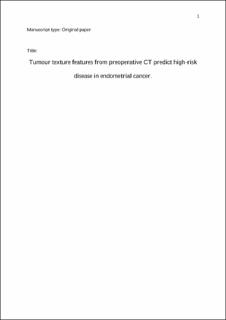| dc.description.abstract | BACKGROUND
To enable more individualised treatment of endometrial cancer, improved methods for preoperative tumour characterization are warranted. Texture analysis is a method for quantification of heterogeneity in images, increasingly reported as a promising diagnostic tool in oncological imaging, but largely unexplored in endometrial cancer
AIM
To explore whether tumour texture features from preoperative computed tomography (CT) are related to known prognostic histopathological features and to outcome in endometrial cancer patients.
MATERIALS AND METHODS
Preoperative pelvic contrast-enhanced CT was performed in 155 patients with histologically confirmed endometrial cancer. Tumour ROIs were manually drawn on the section displaying the largest cross-sectional tumour area, using dedicated texture analysis software. Using the filtration-histogram technique, the following texture features were calculated: mean, standard deviation, entropy, mean of positive pixels (MPP), skewness, and kurtosis. These imaging markers were evaluated as predictors of histopathological high-risk features and recurrence- and progression-free survival using multivariable logistic regression and Cox regression analysis, including models adjusting for high-risk status based on preoperative biopsy, magnetic resonance imaging (MRI) findings, and age.
RESULTS
High tumour entropy independently predicted deep myometrial invasion (odds ratio [OR] 3.7, p=0.008) and cervical stroma invasion (OR 3.9, p=0.02). High value of MPP (MPP5 >24.2) independently predicted high-risk histological subtype (OR 3.7, p=0.01). Furthermore, high tumour kurtosis tended to independently predict reduced recurrence- and progression-free survival (HR 1.1, p=0.06).
CONCLUSION
CT texture analysis yields promising imaging markers in endometrial cancer and may supplement other imaging techniques in providing a more refined preoperative risk assessment that may ultimately enable better tailored treatment strategies. | en_US |
